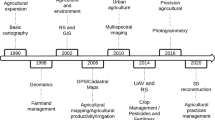Abstract
NOAA-AVHRR data have been more and more used by scientists because of its short temporal resolution, large scope, inexpensive cost and broad wave bands. On macro and middle scale of vegetation remote sensing, NOAA-AVHRR possesses an advantage when compared with other satellites. However, because NOAA-AVHRR also possesses problem of low resolution, data distortion and geometrical distortion, in the area of application of NOAA-AVHRR in large scale vegetation-mapping, the accuracy of vegetation classification should be improved. This paper discuss the feasibility of integrating the geographic data in GIS (Geographical Information System) and remotely sensed data in GIS. Under the environment of GIS, temperature, precipitation and elevation, which serve as main factors affecting vegetation growth, were processed by a mathematical model and qualified into geographic image under a certain grid system. The geographic image were overlaid to the NOAA-AVHRR data which had been compressed and processed. In order to evaluate the usefulness of geographic data for vegetation classification, the area under study was digitally classified by two groups of interpreter: the proposed methodology using maximum likelihood classification assisted by the geographic database and a conventional maximum likelihood classification only. Both result were compared using Kappa statistics. The indices to both the proposed and the conventional digital classification methodology were 0.668 (very good) and 0.563 (good), respectively. The geographic database rendered an improvement over the conventional digital classification. Furthermore, in this study, some problems related to multi-sources data integration are also discussed.
Similar content being viewed by others
References
Brain Berry, 1964. Approaches to Regional Analysis: A Synthesis. Annuals of Association of American Geographers. 54.
Defnies R. S., Townshend, J. R. G., 1994. NDVI-derived land cover classifications at a global scale. Int. J. Remote Sensing, 15, (17).
Donna J. Peuquet, 1988. Representations of Geographic Space: Toward a Conceptal Synthesis. Annuals of the Association of American Geographers, 78(3).
Eidenshink J. C., Faundeen J. L. 1994. The 1km AVHRR global land data set: first stages in implementation. Int. J. Remote Sensing, 15, (17).
Frederic Achard, Christine Estreguil, 1995. Forest Classification of Southeast Asia Using NOAA-AVHRR Data. Remote Sens. Environ., 54.
Frederic Achard, Christine Estreguil, 1995. Forest Classification of Southeast Asia Using NOAA-AVHRR Date. Remote Sens. Environ. 54.
Gutman G. Garik, Aleksandr. M. Ignatov, Steve Orson, 1994. Towards Better Quality of AVHRR Composite Images over Land: Reduction of Cloud Contamination. Remote Sens. Environ., 50.
Gong P., Zheng, X. Shi G. et al., 1994. Large area mapping for global change studies: multitemporal image processing and pattern recognition. GIS’94, Vancouver, B. C.
James M. E., Kalluri S. N., 1994. The Pathfinder AVHRR land data set: An improved coarse resolution data set for terrestrial monitoring. Int. J. Remote Sensing,. 15, (17).
Loveland T. R., Mechent, J. W. Brown J. F. et al., 1995. Seasonal land-cover region of the United States. Annals of the Association of American Geographers, 85.
Moody A., Strahler, 1994. Characteristics of composed AVHRR data and problems in their classification. Int. J. Remote Sensing, 15, (17).
Ortiz M. J., Formaggio, A. R. Epiphanio, J. C. N. 1997. Classification of croplands through integration of remote sensing, GIS and historical database. Int. J. Remote Sensing, 18 (1).
Ruth Defries, Mathew Hansen, John Townshend, 1995. Global Discrimination of Land Cover Types from Metrics Derived from AVHRR Patherfinder Data. Remote Sens. Environ. 54.
Dwived, R. S. 1996. Monitoring of salt-affected soils of the Indo-Gangetic alluvial plains using principal component analysis. Int. J. Remote Sensing, 17 (10).
Townshend J. G. R., 1994. Global data sets for land applications from the Advanced Very High Resolution Radiometer: an introduction. Int. J. Remote Sensing, 15(17).
Tucker, C. J., Townshend, J. R. Goff, T. E. 1985. African land cover classification using satellite data, Science, 227.
Townshend J. R. G., Justice, C. O. Kalb, V. T. 1987. Characterization and classification of south American land cover using satellite data. Int. J. Remote Sensing, 8.
Tong Lee, John A. Richard, Philip H. Swain, 1987. Probabilistic and Evidential Approaches for Multisource Data Analysis. IEEE Transactions on Geoscience and Remote Sensing, GE-25 (3).
Zhu Z., D. L. Evans, 1994. US Forest types and predicted percent forest cover from AVHRR data. PE&RS, 15.
Author information
Authors and Affiliations
Rights and permissions
About this article
Cite this article
Zhuang, D., Ling, Y. & Yoshio, A. Integrated vegetation classification and mapping using remote sensing and GIS techniques. Chin. Geograph.Sc. 9, 49–56 (1999). https://doi.org/10.1007/s11769-999-0020-5
Received:
Issue Date:
DOI: https://doi.org/10.1007/s11769-999-0020-5




